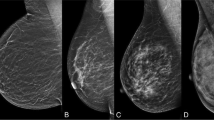Abstract
Screening guidelines recommend that women with 20 % or greater lifetime risk of breast cancer undergo annual breast MRI screening to supplement mammography, irrespective of age. In patients less than 40 years, mammography is often avoided due to concerns about radiation and decreased performance. However, prior studies have been limited by large percentages of women above 40 with decreased breast density. Our purpose was to test whether adding mammography to breast MRI screening compared to breast MRI screening alone in women below 40 increases cancer detection rates. After obtaining IRB approval, chart review identified patients aged 25–40 years undergoing breast MR screening (2005–2014). Demographics, risk factors, BI-RADS assessments, background parenchymal enhancement, and mammographic breast tissue density were recorded. Cancer detection rates, short-term follow-up (BIRADS 3), image-guided biopsy (BIRADS 4,5), and PPV1–3 were calculated. 342 breast MRI exams were identified (average age was 33, 37 % were nulliparous, and 64 % had prior benign biopsy), 226 (66 %) of which underwent concurrent mammography. Risk factors included 64 % with breast cancer in first-degree relative(s), 90 % had heterogeneous or extremely dense breast tissue on mammography, and 16 % were BRCA carriers. Four invasive cancers were detected by MRI (11.7 cancers/1000 examinations, 95 % CI 8.3, 15.1). None of these was detected by mammography, and no cancers were independently identified by mammography. Breast MRI screening in high-risk women under 40 yielded elevated cancer detection rates (11.7/1000). The cancer detection rate for mammography was 0 %, suggesting that MRI alone may be useful in screening high-risk women under 40.
Similar content being viewed by others
References
Lee CH, Dershaw DD, Kopans D et al (2010) Breast cancer screening with imaging: recommendations from the Society of Breast Imaging and the ACR on the use of mammography, breast MRI, breast ultrasound, and other technologies for the detection of clinically occult breast cancer. J Am Coll Radiol 7(1):18–27
Berrington de Gonzalez A, Reeves G (2005) Mammographic screening before age 50 years in the UK: comparison of the radiation risks with the mortality benefits. Br J Cancer 93:590–596
Checka CM, Chun JE, Schnabel FR, Lee J, Toth H (2012) The relationship of mammographic density and age: implications for breast cancer screening. AJR Am J Roentgenol 198(3):W292–W295
Mainiero MB, Lourenco A, Mahoney MC et al (2013) ACR appropriateness criteria breast cancer screening. J Am Coll Radiol 10(1):11–14. doi:10.1016/j.jacr.2012.09.036
Warner E, Messersmith H, Causer P, Eisen A, Shumak R, Plewes D (2008) Systematic review: using magnetic resonance imaging to screen women at high risk for breast cancer. Ann Intern Med 148(9):671–679
Carney PA, Miglioretti DL, Yankaskas BC et al (2003) Individual and combined effects of age, breast density, and hormone replacement therapy use on the accuracy of screening mammography. Ann Intern Med 138(3):168–1675
Heywang-Köbrunner SH, Bick U, Bradley WG Jr et al (2001) International investigation of breast MRI: results of a multicentre study (11 sites) concerning diagnostic parameters for contrast-enhanced MRI based on 519 histopathologically correlated lesions. Eur Radiol 11(4):531–546
Howlader N, Noone AM, Krapcho M et al (eds) (2016). SEER cancer statistics review, 1975–2013, National Cancer Institute. Bethesda, MD http://seer.cancer.gov/csr/1975_2013/. based on November 2015 SEER data submission, posted to the SEER web site Accessed 15 June 2016
Kuhl C, Weigel S, Schrading S et al (2010) Prospective multicenter cohort study to refine management recommendations for women at elevated familial risk of breast cancer: the EVA trial. J Clin Oncol 28(9):1450–1457
Sung JS, Malak SF, Bajaj P, Alis R, Dershaw DD, Morris EA (2011) Screening breast MR imaging in women with a history of lobular carcinoma in situ. Radiology 261(2):414–420. doi:10.1148/radiol.11110091
Friedlander LC, Roth SO, Gavenonis SC (2011) Results of MR imaging screening for breast cancer in high-risk patients with lobular carcinoma in situ. Radiology 261(2):421–427. doi:10.1148/radiol.11103516
Freitas V, Scaranelo A, Menezes R, Kulkarni S, Hodgson D, Crystal P (2013) Added cancer yield of breast magnetic resonance imaging screening in women with a prior history of chest radiation therapy. Cancer 119(3):495–503. doi:10.1002/cncr.27771
Kriege M, Brekelmans CT, Boetes C et al (2004) Efficacy of MRI and mammography for breast-cancer screening in women with a familial or genetic predisposition. New Engl J Med 351(5):427–437
Lehman CD, Lee JM, DeMartini WB et al (2016) Screening MRI in women with a personal history of breast cancer. J Natl Cancer Inst. doi:10.1093/jnci/djv349
Lehman CD, Lee CI, Loving VA, Portillo MS, Peacock S, DeMartini WB (2012) Accuracy and value of breast ultrasound for primary imaging evaluation of symptomatic women 30-39 years of age. AJR Am J Roentgenol 199(5):1169–1177. doi:10.2214/AJR.12.8842
Harvey SC, Di Carlo PA, Lee B, Obadina E, Sippo D, Mullen L (2016) An Abbreviated Protocol for High-Risk Screening Breast MRI Saves Time and Resources. J Am Coll Radiol 13(4):374–380. doi:10.1016/j.jacr.2015.08.015
Kuhl CK, Schrading S, Strobel K, Schild HH, Hilgers RD, Bieling HB (2014) Abbreviated breast magnetic resonance imaging (MRI): first postcontrast subtracted images and maximum-intensity projection-a novel approach to breast cancer screening with MRI. J Clin Oncol 32(22):2304–2310. doi:10.1200/JCO.2013.52.5386
Author information
Authors and Affiliations
Corresponding author
Ethics declarations
Conflict of interest
The authors declare that they have no conflict of interest.
Rights and permissions
About this article
Cite this article
Narayan, A.K., Visvanathan, K. & Harvey, S.C. Comparative effectiveness of breast MRI and mammography in screening young women with elevated risk of developing breast cancer: a retrospective cohort study . Breast Cancer Res Treat 158, 583–589 (2016). https://doi.org/10.1007/s10549-016-3912-y
Received:
Accepted:
Published:
Issue Date:
DOI: https://doi.org/10.1007/s10549-016-3912-y




